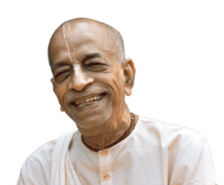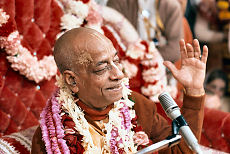
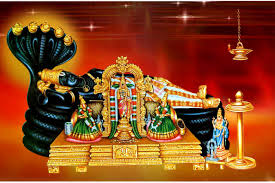
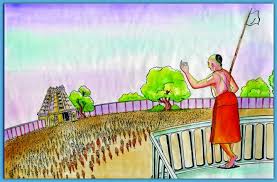
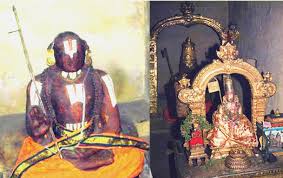
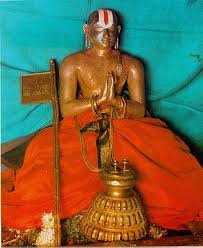
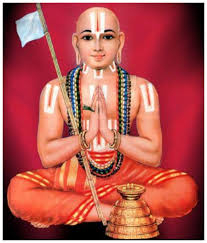
Sri Ramanuja tirobhava tithi [disappearance], Monday February 6, 2017
Mayapura, West Bengal, India time]
Srila Prabhupada glorifies Sripada Ramanuja
compiled by Yasoda nandana dasa
Books : Srimad-Bhagavatam : Canto 1:”Creation” : SB 1.1: Questions by the Sages : SB 1.1.17 : PURPORT :
The Personality of Godhead is never inactive as some less intelligent persons suggest. His works are magnificent and magnanimous. His creations both material and spiritual are all wonderful and contain all variegatedness. They are described nicely by such liberated souls as Śrīla Nārada, Vyāsa, Vālmīki, Devala, Asita, Madhva, Śrī Caitanya, Rāmānuja, Viṣṇusvāmī, Nimbārka, Śrīdhara, Viśvanātha, Baladeva, Bhaktivinoda, Siddhānta Sarasvatī and many other learned and self-realized souls. These creations, both material and spiritual, are full of opulence, beauty and knowledge, but the spiritual realm is more magnificent due to its being full of knowledge, bliss and eternity. The material creations are manifested for some time as perverted shadows of the spiritual kingdom and can be likened to cinemas. They attract people of less intelligent caliber who are attracted by false things. Such foolish men have no information of the reality, and they take it for granted that the false material manifestation is the all in all. But more intelligent men guided by sages like Vyāsa and Nārada know that the eternal kingdom of God is more delightful, larger, and eternally full of bliss and knowledge. Those who are not conversant with the activities of the Lord and His transcendental realm are sometimes favored by the Lord in His adventures as incarnations wherein He displays the eternal bliss of His association in the transcendental realm. By such activities He attracts the conditioned souls of the material world. Some of these conditioned souls are engaged in the false enjoyment of material senses and others in simply negating their real life in the spiritual world. These less intelligent persons are known as karmīs, or fruitive workers, and jñānīs, or dry mental speculators. But above these two classes of men is the transcendentalist known as sātvata, or the devotee, who is busy neither with rampant material activity nor with material speculation. He is engaged in the positive service of the Lord, and thereby he derives the highest spiritual benefit unknown to the karmīs and jñānīs.
4.28.31 : PURPORT : The word bhokṣyate is very important in this verse. Just as a king gives protection to his citizens, these devotees, following the principles of devotional service, will give protection to all the people of the world. The people of the world are very much harassed by so-called religious-principled svāmīs, yogīs, karmīs and jñānīs, but none of these can show the right way to become elevated to the spiritual platform. There are primarily four parties spreading devotional service all over the universe. These are the Rāmānuja-sampradāya, the Madhva-sampradāya, the Viṣṇusvāmi-sampradāya and the Nimbārka-sampradāya. The Madhva-Gauḍīya-sampradāya in particular comes from Lord Caitanya Mahāprabhu. All these devotees are spreading this Kṛṣṇa consciousness movement very widely and giving protection to innocent people who are being so much embarrassed by pseudo-avatāras, -svāmīs, -yogīs and others
Books : Sri Caitanya-caritamrta – 1975 Edition : Cc. Adi-lila : Adi 1: The Spiritual Masters : Adi 1.19 : PURPORT :
The devotees of Orissa are called Uḍiyās, the devotees of Bengal are called Gauḍīyas, and the devotees of southern India are known as Drāviḍa devotees. As there are five provinces in Āryāvarta, so Dākṣiṇātya, southern India, is also divided into five provinces, which are called Pañca-draviḍa. The four Vaiṣṇava ācāryas who are the great authorities of the four Vaiṣṇava disciplic successions, as well as Śrīpāda Śaṅkarācārya of the Māyāvāda school, appeared in the Pañca-draviḍa provinces. Among the four Vaiṣṇava ācāryas, who are all accepted by the Gauḍīya Vaiṣṇavas, Śrī Rāmānuja Ācārya appeared in the southern part of Andhra Pradesh at Mahābhūtapurī, Śrī Madhva Ācārya appeared at Pājakam (near Vimānagiri) in the district of Mangalore, Śrī Viṣṇusvāmī appeared at Pāṇḍya, and Śrī Nimbārka appeared at Muṅgera-patana in the extreme south.
ooks : Sri Caitanya-caritamrta – 1975 Edition : Cc. Adi-lila : Adi 7: Lord Caitanya in Five Features : Adi 7.149 : PURPORT : In this connection it may be mentioned that sometimes the sahajiyā class of devotees opine that Prakāśānanda Sarasvatī and Prabodhānanda Sarasvatī are the same man. Prabodhānanda Sarasvatī was a great Vaiṣṇava devotee of Lord Caitanya Mahāprabhu, but Prakāśānanda Sarasvatī, the head of the Māyāvādī sannyāsīs in Benares, was a different person. Prabodhānanda Sarasvatī belonged to the Rāmānuja-sampradāya, whereas Prakāśānanda Sarasvatī belonged to the Śaṅkarācārya-sampradāya. Prabodhānanda Sarasvatī wrote a number of books, among which are the Caitanya-candrāmṛta, Rādhā-rasa-sudhā-nidhi, Saṅgīta-mādhava, Vṛndāvana-śataka and Navadvīpa-śataka. While traveling in southern India, Caitanya Mahāprabhu met Prabodhānanda Sarasvatī, who had two brothers, Veṅkaṭa Bhaṭṭa and Tirumalaya Bhaṭṭa, who were Vaiṣṇavas of the Rāmānuja-sampradāya. Gopāla Bhaṭṭa Gosvāmī was the nephew of Prabodhānanda Sarasvatī. From historical records it is found that Śrī Caitanya Mahāprabhu traveled in South India in the year 1433 śakābda (A.D. 1511) during the Cāturmāsya period, and it was at that time that He met Prabodhānanda, who belonged to the Rāmānuja-sampradāya. How then could the same person meet Him as a member of the Śaṅkara-sampradāya in 1435 śakābda, two years later? It is to be concluded that the guess of the sahijiyā-sampradāya that Prabodhānanda Sarasvatī and Prakāśānanda Sarasvatī were the same man is a mistaken idea.
Books : Sri Caitanya-caritamrta – 1975 Edition : Cc. Madhya-lila : Madhya 9: Lord Sri Caitanya Mahaprabhu’s Travels to the Holy Places : Madhya 9.11 : PURPORT : yas tu narayanam devam brahma-rudradi-daivataih samatvenaiva vikseta sa pasandi bhaved dhruvam :
It may be noted that these particular Deities of Rāma and Sītā have been worshiped from the time of King Ikṣvāku. Indeed, they were worshiped by the royal princes even before the appearance of Lord Rāmacandra. Later, during Lord Rāmacandra’s presence, the Deities were worshiped by Lakṣmaṇa. It is said that just three months before his disappearance, Śrī Madhvācārya received these Deities and installed them in the Uḍupī temple. Since then the Deities have been worshiped by the Madhvācārya-sampradāya at that monastery. As far as the Śrī Vaiṣṇavas are concerned, beginning with Rāmānujācārya, they also worshiped Deities of Sītā-Rāma. Sītā-Rāma Deities are also being worshiped in Tirupati and other places. From the Śrī Rāmānuja-sampradāya there is another branch known as Rāmānandī or Rāmāt, and the followers of that branch also worship Deities of Sītā-Rāma very rigidly. The Rāmānuja-sampradāya Vaiṣṇavas prefer the worship of Lord Rāmacandra to that of Rādhā-Kṛṣṇa.
Books : Teachings of Lord Kapila, the Son of Devahuti : TLK 14: Bhakti as Ultimate Liberation : TLK Vs 31 : PURPORT :
We have to accept Kṛṣṇa through the disciplic succession. There are four sampradāyas, disciplic successions. One comes from Lord Brahmā (the Brahma-sampradāya), and another comes from Lakṣmī, the goddess of fortune, (the Śrī-sampradāya). There are also the Kumāra-sampradāya and the Rudra-sampradāya. At the present moment, the Brahmā sampradāya is represented by the Madhva-sampradāya, and we belong to the Madhva-Gauḍīya-sampradāya. Our original sampradāya stems from Madhvācārya. In that sampradāya there was Mādhavendra Purī, and Mādhavendra Purī’s disciple was Śrī Īśvara Purī. Śrī Īśvara Purī’s disciple was Lord Caitanya Mahāprabhu. Thus we are coming in the disciplic succession from Śrī Caitanya Mahāprabhu, and therefore our sampradāya is called the Madhva-Gauḍīya-sampradāya. It is not that we have manufactured a sampradāya; rather, our sampradāya stems from Lord Brahmā. There is also the Rāmānuja-sampradāya, which comes from the Śrī-sampradāya, and there is the Viṣṇusvāmī-sampradāya, which comes from the Rudra-sampradāya. The Nimbāditya-sampradāya comes from the Kumāra-sampradāya. If we do not belong to any sampradāya, our conclusion is fruitless. It is not that one should think, “I am a big scholar, and I can interpret Bhagavad-gītā in my own way. All these sampradāyas are useless.” We cannot manufacture our own comments. There are many commentaries made in this way, and they are all useless. They have no effect. We have to accept the philosophy as it was contemplated by Lord Brahmā, Nārada, Madhvācārya, Mādhavendra Purī and Īśvara Purī. These great ācāryas are beyond the imperfections of so-called scholars. Mundane scientists and philosophers use the words “perhaps” and “maybe” because they cannot arrive at a proper conclusion. They are simply speculating, and mental speculation cannot be perfect.
Lectures : Srimad-Bhagavatam Lectures : Canto 3: Lectures : SB 3.26: Lectures : Srimad-Bhagavatam 3.26.4 — Bombay, December 16, 1974 : 741216SB.BOM :
So do you think that the ācāryas and the śāstra have advised them to waste their time by worshiping a stone? It is all recommended by the ācāryas, big, big ācāryas. Just like Rāmānujācārya. He established hundreds of temples all over India, Lakṣmī-Nārāyaṇa temple especially, the Rāmānuja-sampradāya. Similarly, Caitanya Mahāprabhu’s sampradāya established hundreds of temples of Rādhā-Kṛṣṇa. Big, big ācārya. Do you mean to say they did mistake? As some people of our India, they say, “There is no need of worshiping in the temple.” No. Why not need? Ācāryopāsanam, that is recommended, jñāna. Ācārya… Ācāryas, they have established temples, many hundreds of thousands of temples, of Viṣṇu mandira.
ooks : Sri Caitanya-caritamrta – 1975 Edition : Cc. Adi-lila : Adi 7: Lord Caitanya in Five Features : Adi 7.128 : TRANSLATION : om ity ekaksaram brahma vyaharan mam anusmaran yah prayati tyajan deham sa yati paramam gatim :
This verse indicates that oṁkāra, or praṇava, is a direct representation of the Supreme Personality of Godhead. Therefore if at the time of death one simply remembers oṁkāra, he remembers the Supreme Personality of Godhead and is therefore immediately transferred to the spiritual world. Oṁkāra is the basic principle of all Vedic mantras, for it is a representation of Lord Kṛṣṇa, understanding of whom is the ultimate goal of the Vedas, as stated in the Bhagavad-gītā (vedaiś ca sarvair aham eva vedyaḥ). Māyāvādī philosophers cannot understand these simple facts explained in the Bhagavad-gītā, and yet they are very proud of being Vedāntīs. Sometimes, therefore, we refer to the Vedāntī philosophers as Vidantīs, those who have no teeth (vi means “without,” and dantī means “possessing teeth”). The statements of the Śaṅkara philosophy, which are the teeth of the Māyāvādī philosopher, are always broken by the strong arguments of Vaiṣṇava philosophers such as the great ācāryas, especially Rāmānujācārya. Śrīpāda Rāmānujācārya and Madhvācārya break the teeth of the Māyāvādī philosophers, who can therefore be called Vidantīs, “toothless.”
Books : Sri Caitanya-caritamrta – 1975 Edition : Cc. Madhya-lila : Madhya 9: Lord Sri Caitanya Mahaprabhu’s Travels to the Holy Places : Madhya 9.79 : PURPORT :
There was also a celebrated disciple of Rāmānujācārya‘s known as Kūreśa. Śrī Rāmapillā was the son of Kūreśa, and his son was Vāgvijaya Bhaṭṭa, whose son was Vedavyāsa Bhaṭṭa, or Śrī Sudarśanācārya. When Sudarśanācārya was an old man, the Mohammedans attacked the temple of Raṅganātha and killed about twelve hundred Śrī Vaiṣṇavas. At that time the Deity of Raṅganātha was transferred to the temple of Tirupati in the kingdom of Vijaya-nagara. The governor of Gingeeṅ, Goppaṇārya, brought Śrī Raṅganātha from the temple of Tirupati to a place known as Siṁha-brahma, where the Lord was situated for three years. In the year 1293 Śaka (A.D. 1372) the Deity was reinstalled in the Raṅganātha temple. On the eastern wall of the Raṅganātha temple is an inscription written by Vedānta-deśika relating how Raṅganātha was returned to the temple.
